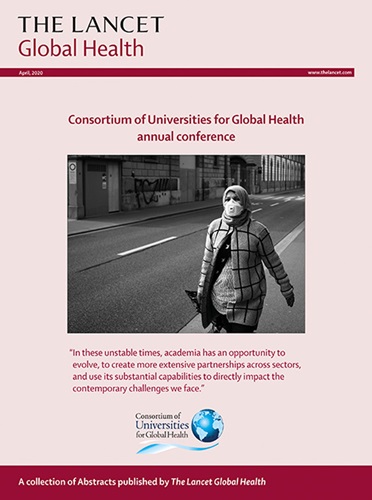Assessing the effect of health system resources on HIV and tuberculosis programmes in Malawi: a modelling study.
IF 19.9
1区 医学
Q1 PUBLIC, ENVIRONMENTAL & OCCUPATIONAL HEALTH
引用次数: 0
Abstract
BACKGROUND Malawi is progressing towards UNAIDS and WHO End TB Strategy targets to eliminate HIV/AIDS and tuberculosis. We aimed to assess the prospective effect of achieving these goals on the health and health system of the country and the influence of consumable constraints. METHODS In this modelling study, we used the Thanzi la Onse (Health for All) model, which is an individual-based multi-disease simulation model that simulates HIV and tuberculosis transmission, alongside other diseases (eg, malaria, non-communicable diseases, and maternal diseases), and gates access to essential medicines according to empirical estimates of availability. The model integrates dynamic disease modelling with health system engagement behaviour, health system use, and capabilities (ie, personnel and consumables). We used 2018 data on the availability of HIV and tuberculosis consumables (for testing, treatment, and prevention) across all facility levels of the country to model three scenarios of HIV and tuberculosis programme scale-up from Jan 1, 2023, to Dec 31, 2033: a baseline scenario, when coverage remains static using existing consumable constraints; a constrained scenario, in which prioritised interventions are scaled up with fixed consumable constraints; and an unconstrained scenario, in which prioritised interventions are scaled up with maximum availability of all consumables related to HIV and tuberculosis care. FINDINGS With uninterrupted medical supplies, in Malawi, we projected HIV and tuberculosis incidence to decrease to 26 (95% uncertainty interval [UI] 19-35) cases and 55 (23-74) cases per 100 000 person-years by 2033 (from 152 [98-195] cases and 123 [99-160] cases per 100 000 person-years in 2023), respectively, with programme scale-up, averting a total of 12·21 million (95% UI 11·39-14·16) disability-adjusted life-years. However, the effect was compromised by restricted access to key medicines, resulting in approximately 58 700 additional deaths (33 400 [95% UI 22 000-41 000] due to AIDS and 25 300 [19 300-30 400] due to tuberculosis) compared with the unconstrained scenario. Between 2023 and 2033, eliminating HIV treatment stockouts could avert an estimated 12 100 deaths compared with the baseline scenario, and improved access to tuberculosis prevention medications could prevent 5600 deaths in addition to those achieved through programme scale-up alone. With programme scale-up under the constrained scenario, consumable stockouts are projected to require an estimated 14·3 million extra patient-facing hours between 2023 and 2033, mostly from clinical or nursing staff, compared with the unconstrained scenario. In 2033, with enhanced screening, 188 000 (81%) of 232 900 individuals projected to present with active tuberculosis could start tuberculosis treatment within 2 weeks of initial presentation if all required consumables were available, but only 8600 (57%) of 15 100 presenting under the baseline scenario. INTERPRETATION Ignoring frailties in the health-care system, in particular the potential non-availability of consumables, in projections of HIV and tuberculosis programme scale-up might risk overestimating potential health impacts and underestimating required health system resources. Simultaneous health system strengthening alongside programme scale-up is crucial, and should yield greater benefits to population health while mitigating the strain on a heavily constrained health-care system. FUNDING Wellcome and UK Research and Innovation as part of the Global Challenges Research Fund.评估马拉维卫生系统资源对艾滋病毒和结核病计划的影响:一项建模研究。
背景马拉维正在逐步实现联合国艾滋病规划署和世界卫生组织消除结核病战略的目标,即消灭艾滋病毒/艾滋病和结核病。在这项建模研究中,我们使用了 Thanzi la Onse(人人享有健康)模型,该模型是一个基于个人的多疾病模拟模型,可模拟艾滋病毒和结核病的传播,以及其他疾病(如疟疾、非传染性疾病和孕产妇疾病),并根据对可用性的经验估计来决定基本药物的获取。该模型将动态疾病建模与卫生系统参与行为、卫生系统使用和能力(即人员和消耗品)相结合。我们使用 2018 年全国各级医疗机构的艾滋病和结核病耗材(用于检测、治疗和预防)可用性数据,模拟了从 2023 年 1 月 1 日到 2033 年 12 月 31 日艾滋病和结核病计划扩展的三种情景:基线情景,即在现有消耗品限制条件下,覆盖范围保持不变;受限情景,即在固定消耗品限制条件下,扩大优先干预措施的规模;无限制情景,即在最大限度地提供与艾滋病毒和结核病护理相关的所有消耗品的情况下,扩大优先干预措施的规模。结果我们预测,在马拉维,如果医疗用品不间断供应,随着计划的扩大,到 2033 年,每 100 000 人年的艾滋病毒和结核病发病率将分别降至 26 例(95% 不确定区间 [UI] 19-35)和 55 例(23-74)(2023 年为每 100 000 人年 152 [98-195] 例和 123 [99-160] 例),总共可避免 1,200 万-2,100 万(95% 不确定区间 [UI] 11-39-14-16)个残疾调整寿命年。然而,由于关键药物的获取受到限制,与无限制情景相比,效果大打折扣,导致死亡人数增加约 58 700 人(艾滋病导致 33 400 人 [95% UI 22 000-41 000],结核病导致 25 300 人 [19 300-30 400])。在 2023 年至 2033 年期间,与基线情景相比,消除艾滋病毒治疗库存可避免约 12 100 例死亡,而改善结核病预防药物的获取可避免 5600 例死亡,这还不包括仅通过扩大方案规模实现的死亡。与无限制情景相比,在有限制情景下扩大计划规模后,预计 2023 年至 2033 年期间,消耗品缺货将需要额外的 1400 万至 300 万个面向患者的小时,其中大部分来自临床或护理人员。2033 年,在加强筛查的情况下,如果能获得所有必需的消耗品,预计 232 900 名活动性肺结核患者中的 188 000 人(81%)可在初次发病后 2 周内开始接受肺结核治疗,但在基线情景下,15 100 名患者中只有 8600 人(57%)可在初次发病后 2 周内开始接受肺结核治疗。在扩大项目规模的同时加强医疗系统至关重要,这将为人口健康带来更大的益处,同时减轻严重受限的医疗系统的压力。
本文章由计算机程序翻译,如有差异,请以英文原文为准。
求助全文
约1分钟内获得全文
求助全文
来源期刊

Lancet Global Health
PUBLIC, ENVIRONMENTAL & OCCUPATIONAL HEALTH-
CiteScore
44.10
自引率
1.20%
发文量
763
审稿时长
10 weeks
期刊介绍:
The Lancet Global Health is an online publication that releases monthly open access (subscription-free) issues.Each issue includes original research, commentary, and correspondence.In addition to this, the publication also provides regular blog posts.
The main focus of The Lancet Global Health is on disadvantaged populations, which can include both entire economic regions and marginalized groups within prosperous nations.The publication prefers to cover topics related to reproductive, maternal, neonatal, child, and adolescent health; infectious diseases (including neglected tropical diseases); non-communicable diseases; mental health; the global health workforce; health systems; surgery; and health policy.
 求助内容:
求助内容: 应助结果提醒方式:
应助结果提醒方式:


